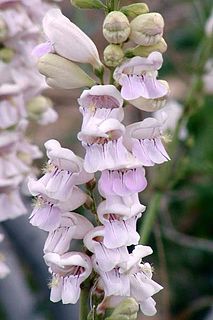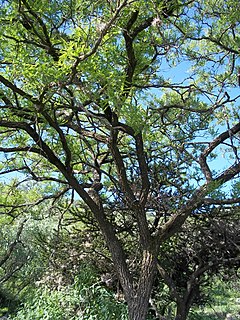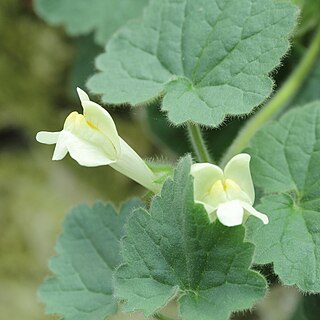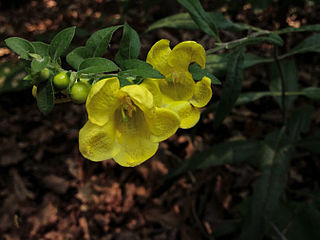
Penstemon, the beardtongues, is a large genus of roughly 250 species of flowering plants native mostly to the Nearctic, but with a few species also found in the North American portion of the Neotropics. It is the largest genus of flowering plants endemic to North America. Formerly placed in the family Scrophulariaceae by the Cronquist system, new genetic research has placed it in the vastly expanded family Plantaginaceae.

Smilax ornata is a perennial trailing vine with prickly stems that is native to Mexico and Central America. Common names include sarsaparilla, Honduran sarsaparilla, and Jamaican sarsaparilla.

Joseph Pennell was an American artist and author.

Calceolaria, also called lady's purse, slipper flower and pocketbook flower, or slipperwort, is a genus of plants in the family Calceolariaceae, sometimes classified in Scrophulariaceae by some authors. This genus consists of about 388 species of shrubs, lianas and herbs, and the geographical range extends from Patagonia to central Mexico, with its distribution centre in Andean region. Calceolaria species have usually yellow or orange flowers, which can have red or purple spots. The Calceolaria Herbeohybrida group, also called C. herbeohybrida Voss, is a group of ornamental hybrids known only in cultivation, called florists slipperwort.
The Flora of North America North of Mexico is a multivolume work describing the native plants and naturalized plants of North America, including the United States, Canada, St. Pierre and Miquelon, and Greenland. It includes bryophytes and vascular plants. All taxa are described and included in dichotomous keys, distributions of all species and infraspecific taxa are mapped, and about 20% of species are illustrated with line drawings prepared specifically for FNA. It is expected to fill 30 volumes when completed and will be the first work to treat all of the known flora north of Mexico.

Galvezia is a genus of perennial plants which are native to western North America, western South America and the Galapagos Islands. The genus is currently placed in the family Plantaginaceae, having been formerly classified under Scrophulariaceae. It is named in honour of José de Gálvez, a colonial official in New Spain during the 1700s.

Agalinis is a genus of about 70 species in North, Central, and South America that until recently was aligned with members of the family Scrophulariaceae. As a result of numerous molecular phylogenetic studies based on various chloroplast DNA (cpDNA) loci, it was shown to be more closely related to members of the Orobanchaceae. Agalinis species are hemiparasitic, which is a character that in part describes the Orobanchaceae.

Monarda punctata is a herbaceous plant in the mint family, Lamiaceae, that is native to eastern Canada, the eastern United States and northeastern Mexico. Common names include spotted beebalm and horsemint.

Eysenhardtia is a genus of flowering plants in the legume family, Fabaceae. It belongs to the subfamily Faboideae. Members of the genus are commonly known as Kidneywoods.

Asarina is a flowering plant genus of only one species, Asarina procumbens, the trailing snapdragon, which is native to southern Europe. Originally placed in the Scrophulariaceae, the genus has more recently been moved to the Plantaginaceae. Species from North America formerly placed in the genus Asarina are now placed in Holmgrenanthe, Lophospermum, Mabrya and Maurandya, as well as Neogaerrhinum. Asarina is now regarded as exclusively an Old World genus.

Maurandya is a genus of flowering plants in the family Plantaginaceae, native to Mexico and the south west United States. They sprawl or climb by means of twining leaf stalks. One of the four species, Maurandya barclayana, is widely cultivated as an ornamental plant.
Francis Whittier Pennell was an American botanist best known for his studies of the Scrophulariaceae. Employed by the New York Botanical Garden and then by the Academy of Natural Sciences of Philadelphia, he carried out botanical research in both North America and South America.

Castilleja integra, with the common name wholeleaf Indian paintbrush, is an herbaceous perennial plant native to the Southwestern United States.

Aureolaria virginica, the downy yellow false foxglove or downy oak leach, is a perennial forb native to the eastern United States and Canada, which produces yellow flowers in summer.

Erythranthe, the monkey-flowers and musk-flowers, is a diverse plant genus with at least 111 members in the family Phrymaceae. Erythranthe was originally described as a separate genus, then generally regarded as a section within the genus Mimulus, and recently returned to generic rank. Mimulus sect. Diplacus was segregated from Mimulus as a separate genus at the same time. Mimulus remains as a small genus of eastern North America and the Southern Hemisphere. Molecular data show Erythranthe and Diplacus to be distinct evolutionary lines that are distinct from Mimulus as strictly defined, although this nomenclature is controverisal.
Ira Waddell Clokey (1878-1950) was an American mining engineer and botanist active in the western United States. He first studied at the University of Illinois, then moved to Harvard University, graduating with a Bachelor of Science in mining engineering in 1903. From 1904 to 1915, Clokey worked as a mining engineer in Mexico. In his spare time he collected plant specimens for his personal herbarium, which, however, was almost completely destroyed during a fire in 1912. In 1921, Clokey completed a Master of Science in plant pathology from Iowa State University.

Achetaria is a genus in the family Plantaginaceae. It contains ten species and is found in South America.
Adenosma is a genus of flowering plants belonging to the family Plantaginaceae.
Anisantherina is a genus of flowering plants belonging to the family Orobanchaceae.
Cheilophyllum is a genus of flowering plants belonging to the family Plantaginaceae.













